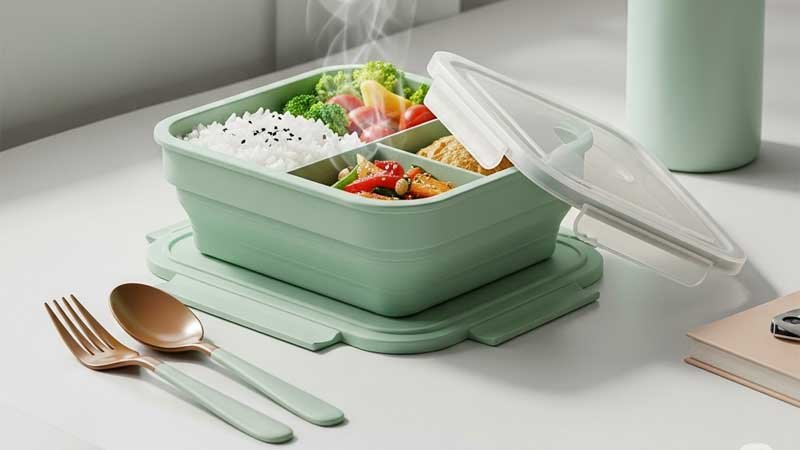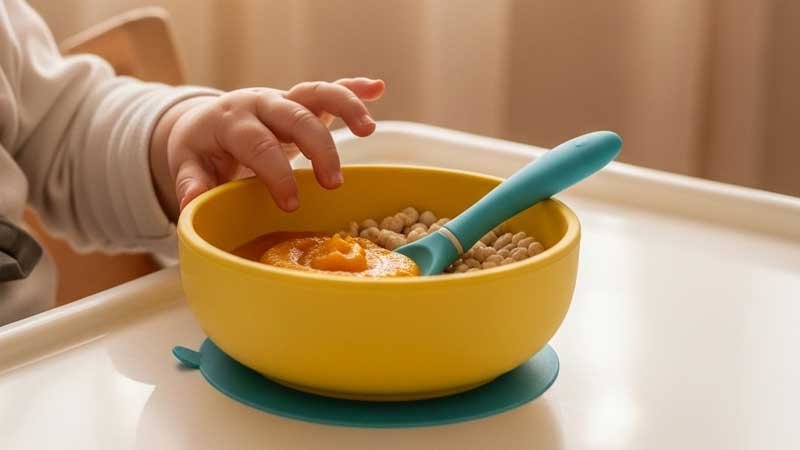Two common materials for food-grade products are silicone and TPE.. Both are soft, non-toxic, and easy to shape. But when it comes to real-world use, their performance can be quite different.
In this article, we’ll walk you through the basics, compare key properties, and look at how each material performs in practical applications, so you can make the right choice for your needs.
What Are Silicone and TPE?
Silicone
Silicone is a polymer made from silicon, oxygen, carbon, and hydrogen. It has a stable chemical structure with a crosslinked network. After high-temperature curing, it becomes highly heat-resistant, inert, and flexible.
There are two common types: platinum-cured silicone and peroxide-cured silicone. Platinum-cured silicone is considered cleaner and more environmentally friendly. Because of its safety, it’s widely used in baby products, kitchenware, and medical devices.
TPE
TPE (Thermoplastic Elastomer) is a group of materials that combine properties of rubber and plastic. It can be injection-molded like plastic, but also feels soft and elastic like rubber. Common types include TPR, TPU, and SEBS, each with slightly different formulas and features.
TPE is easy to process and usually costs less to produce. However, it may not perform as well as silicone in terms of safety and heat resistance.

How Do Silicone and TPE Compare?
When choosing materials for food-contact products, understanding the differences between silicone and TPE is key. Both are flexible and widely used, but their performance, safety, and durability vary in important ways.
Here’s a clear side-by-side comparison to help you make an informed choice.
| Performance | Silicone | TPE (Thermoplastic Elastomer) |
| Temperature Range | -60°C to 230°C, stable for long-term use | Typically -40°C to 100–130°C |
| Chemical Resistance | Resistant to acids, alkalis, oils, and alcohol; no migration risk | Sensitive to oils; some formulas may leach additives |
| Softness & Feel | Matte finish, soft with good rebound | More plastic-like; some types feel harder or sticky |
| Safety Certification | Easily passes FDA, LFGB, and other food-grade standards | Must use certified food-safe grades |
| Ease of Cleaning | Can be boiled or steam-sterilized; no odor | Not heat-resistant; absorbs oils and stains easily |
| Molding Efficiency | Compression molding takes longer; suits complex parts | Fast injection molding; ideal for mass production |
| Cost & Recyclability | More expensive but long-lasting and reusable | Lower cost, recyclable, but shorter lifespan |
How Do Silicone and TPE Perform in Real Food Container Applications?
Silicone and TPE may seem similar at first, but they behave quite differently in real use. Let’s look at how each performs across common kitchen and baby product scenarios.
Sealing Lids: Silicone Wins
- Silicone offers excellent rebound and flexibility. It seals tightly onto glass, stainless steel, or plastic containers—almost like a vacuum. It works well in the fridge, freezer, and microwave, even with hot-and-cold cycles.
- TPE can be used for seals, but it may lose shape under heat and doesn’t hold a seal as long.
Recommended: Food-grade silicone
Best for: Repeated opening/closing, heat/cold shifts, airtight kitchen storage
Lunch Boxes & Collapsible Containers: Silicone Handles Heat, TPE Is Lightweight
- Silicone is foldable, leak-proof, and microwave-safe, perfect for hot meals on the go.
- TPE is thinner and lighter, ideal for cold food. But it may soften or release odor when heated.
Recommended:
- For hot meals → Food-grade silicone
- For cold or lightweight use → Food-grade TPE
Best for: Work lunches, school meals, travel bowls
Freezer Boxes & Ice Trays: Silicone Handles the Cold Better
- Silicone stays flexible down to -60°C. Even after deep freezing, it remains soft and easy to bend, making it simple to pop out ice.
- TPE usually handles down to -40°C. It tends to harden and makes unmolding more difficult.
Recommended: Food-grade silicone
Best for: Ice cube trays, juice molds, breast milk storage

Baby Food Containers: Silicone Is the Only Safe Choice
Baby spoons, bottles, and teething items need the highest level of safety. Silicone is non-toxic, odorless, BPA-free, and highly stable. It’s safe for chewing, sterilizing, and heating. TPE may require additives to soften and must be specially formulated for baby use.
Recommended: Platinum-cured food-grade silicone
Best for: Suction bowls, bottle valves, baby straws
Takeout Containers: TPE Is More Cost-Effective
TPE is great for mass production by injection molding. It’s cheaper and works well for disposable or reusable restaurant containers. For cold food or short-term use, low-cost food-grade TPE can be a smart option.
Recommended: Certified low-cost TPE
Best for: Takeout boxes, delivery packaging, catering trays
Reusable Kitchen Storage: Silicone Lasts Longer
For repeated washing, dishwashing, and steam heating, silicone holds up better. It doesn’t yellow, scratch, or get sticky over time. TPE may age faster, becoming sticky or developing odors.
Recommended: Food-grade silicone
Best for: Grain containers, spice boxes, steam trays, long-term reusable storage
| Food Container Type | Recommended Material | Why It Works Well |
| Sealing lids | Silicone | Strong seal, heat and cold resistant |
| Foldable lunch boxes | Silicone or TPE | Silicone for heat, TPE for light use |
| Freezer molds | Silicone | Stays flexible, easy to release |
| Baby food containers | Silicone | Safe, stable, and non-toxic |
| Takeout & delivery trays | TPE (certified) | Cost-effective for short-term use |
| Reusable kitchen storage | Silicone | Durable, long-lasting, easy to clean |

FAQs: Common Questions About Silicone and TPE
Q1: Is TPE a Type of Plastic? Is It Safe for Food?
TPE sits between rubber and plastic. With the right formulation, it can be safe for food contact. However, formulations vary by manufacturer, so always check for food-grade certification.
Q2: Why Does TPE Sometimes Have a Smell?
Some TPEs contain volatile additives. These can release a light odor at first. Washing thoroughly or soaking in hot water before use can help reduce the smell.
Q3: Can Silicone Go in the Microwave?
Yes. Food-grade silicone can handle temperatures above 230°C. It’s safe for use in microwaves, ovens, and steamers.
Q4: Which Material Is More Eco-Friendly?
Silicone is great for long-term, repeated use. TPE is easier to recycle. For short-term use, TPE may be more eco-friendly. For durable, long-lasting products, silicone is usually the better choice.

Conclusion
Silicone and TPE both have their strengths. TPE offers flexibility and cost advantages for short-term or disposable use. Silicone, on the other hand, stands out in safety, durability, and long-term performance—especially for baby products, high-heat use, and reusable containers.
Looking to develop your own line of food-grade silicone items? We’re here to help. With top-quality materials, advanced production, and years of experience, our team can support you from design to mold to final product. Contact us today to create safe, stylish, and reliable silicone products tailored to your market.